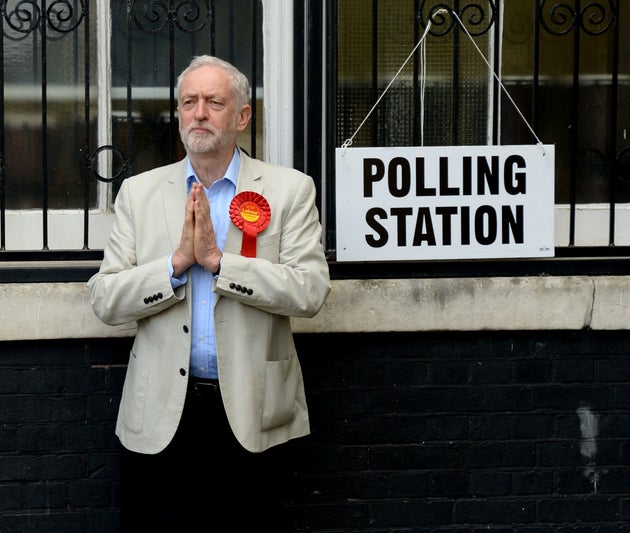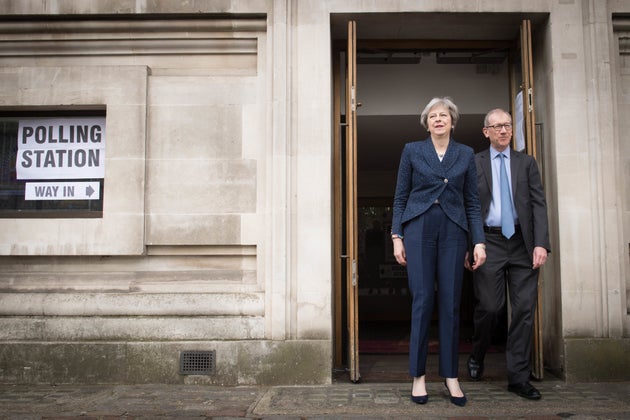
READ: Paul Waugh’s Guide To What To Look Out For And When On Election Night
Polls have closed in the biggest round of voting since the general election last year when Jeremy Corbyn’s surge at the polls humiliated Theresa May.
Some 150 town halls and just over 4,000 council seats are up for grabs, with more than seven million people are expected to cast their ballots.
The polls closing came after anger in some areas after residents reported that they were prevented from voting.
Bromley, Gosport, Swindon, Watford and Woking councils have all trialled a scheme to get voters to show IDs – but MPs and councillors have said people, including elderly residents, were being turned away because they did not have appropriate identification.
In the wake of the Grenfell Tower tragedy, all eyes will be on the Royal Borough of Kensington and Chelsea as counting gets underway.
Extraordinary local anger erupted at the Conservative-run council after the inferno in June, which took 71 lives, and hopes will be high among Labour activists that they can clinch power despite a flurry of new parties competing for voters’ backing.
As austerity and Windrush continue to dominate the headlines, May is under pressure and Labour is expected to benefit by making gains in key council areas, including Manchester’s Trafford, which is tipped to shift from Tory control to no-overall control, and Plymouth.
Jeremy Corbyn’s party is also hopeful of taking London’s Hillingdon but key figures have talked down the party’s chances of snatching key Tory strongholds in the capital, including Westminster and Wandsworth.
Elsewhere in London, the Tories may be optimistic about holding on to Barnet council after Labour became embroiled in a row over antisemitism. The area has a sizeable Jewish population.

Nationally, the Tories are hoping that their handling of the economy, as the country enjoys record employment levels, will resonate with voters, as much as low council taxes, in Conservative boroughs.
As Jeremy Corbyn made clear in his final Prime Minister’s Question Time on the eve-of-poll, Labour is hoping that the public will react against years of Tory cuts to services nationally and locally.
Like last year, Corbyn has tried to make this election a referendum on ‘austerity’. If he gains councils like North East Lincolnshire or Kirklees in Yorkshire, he may think the message is just as powerful.
Unlike last year’s local elections in rural county shires, this year most of the councils in play are in big cities and towns.
In many councils, just a third of the seats are being contested. But in all 32 London boroughs, as well as Birmingham, Manchester, Leeds and Newcastle-upon-Tyne, every single seat is up for election for the first time since 2014.
As part of this festival of democracy, elections take place in 34 metropolitan boroughs, 67 non-metropolitan districts, 17 ‘unitary’ authorities, five directly elected Mayors and one Metro Mayor for the Sheffield City region.
THREE KEY BATTLEGROUNDS – BY HUFFPOST UK’S PAUL WAUGH
Barnet (expected declaration time 4am)
The 2017 general election showed that London is more than ever a Labour city. But while Jeremy Corbyn’s popularity in the capital drove the surge, there are medium-term demographic changes that also point to big problems for the Tories. And Barnet is a classic area where those changes have been keenly felt.
This borough is famously home to Margaret Thatcher’s Finchley seat and has never been run by Labour since it was first created in 1965. But in recent years the party has increased its presence and it now has 30 councillors, just one behind the Tories.
Activists report a ‘remarkable response’ on the doorstep in recent weeks in the crunch ward of High Barnet. This is a ward Labour has never won, and where it usually comes third, but it could take it following a big increase in younger, more diverse residents – many of whom have been priced out of flats in nearby Camden and Islington. If Labour can win High Barnet and get at least one councillor in Child’s Hill ward, it could squeak a working majority.
Even Corbyn’s critics in the party believe that the anti-semitism row, while having upset many voters, won’t do damage in key wards. The council has a big Jewish population yet it tends not to be concentrated in marginal wards. Among the wards in play, West Hendon has been held by Labour for 40 years and is not thought at risk. In Hale, and Child’s Hill, activists report that voters are reassured by the strong local Labour Jewish tradition and the need to topple the Tories.
Trafford (declaration time 2am)
Jeremy Corbyn kicked off his local elections campaign in Trafford, which is one of only two Tory-run metropolitan boroughs in England. It is also the only bit of blue on the map of Greater Manchester. Stuffed full of some of the wealthiest homes in the North West, it has only briefly been under Labour rule in the 1990s. Yet the Conservatives need to lose just two seats and the council will be plunged into ‘No Overall Control’ territory.
The problem for Labour is that it to take control itself it will need an unprecedented victory in Tory areas, and not just its own heartlands in the north end of the borough near Old Trafford football ground. Last year’s Greater Manchester Mayoral election saw Andy Burnham win the true blue ward of Hale Central, but local Labour MPs don’t expect a repeat of that shock result.
There is a worry among some Tories however that they could lose a ward in Altrincham. That would matter not just locally but also down in Westminster. Why? Because the chairman of the backbench 1922 committee Sir Graham Brady is the local MP.
Dudley (declaration time 3am)
This West Midlands council has changed hands regularly between Labour and the Tories over the years. Its Parliamentary seats are just as volatile and just as sought-after. Labour’s Ian Austin clung on in last year’s election (by just 22 votes) in Dudley North, while neighbouring Mike Wood nearly doubled the Tory majority to 7,730 in Dudley South.
The council is officially ‘No Overall Control’ but is run by an alliance of 28 Tories and six UKIP councillors. Labour has 35 seats. Just what happens to the UKIP votes is the key test, so watch for their seats in wards like Sedgley. The council is on such a knife-edge that it could end up with either Labour taking control or the Tories ending up as largest party.
One indication of just how important the borough is came last week when Theresa May herself staged a quick campaign visit. But Corbyn too has been on the stump last month.